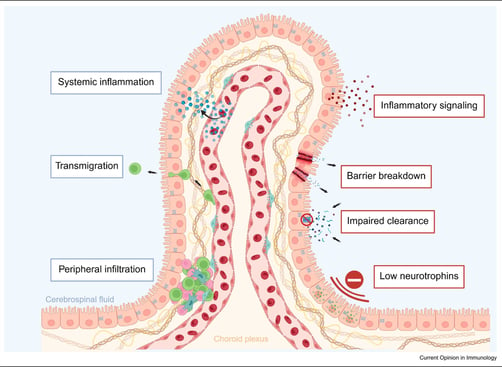Recent discoveries
The choroid plexus (CP) plays a crucial role in supporting the central nervous system (CNS) by producing cerebrospinal fluid, facilitating brain-immune interactions, removing waste, and releasing proneuronal signals.
Despite its physiological importance, the CP's role in neurological diseases is often overlooked. Interactions between resident CNS cells like microglia and peripheral immune cells can lead to inflammation, creating a neurotoxic environment associated with neuroinflammatory diseases. Additionally, metabolic disturbances can damage neurons and their supporting cells, resulting in neurodegeneration. Research suggests that neuroinflammatory and neurodegenerative conditions share significant similarities, linked by core CP abnormalities such as immune cell infiltration, barrier breakdown, and impaired clearance of neurotoxins. This highlights the necessity of studying both conditions in parallel to enhance understanding and management of neuroinflammation and neurodegeneration.






Our Publications:
Explore Dr. Putterman's extensive research publications, showcasing advancements in medicine, immunology, and microbiology from his work at leading institutions.


The choroid plexus (CP) plays a crucial role in supporting the central nervous system (CNS) by producing cerebrospinal fluid, facilitating brain-immune interactions, removing waste, and releasing proneuronal signals.
Despite its physiological importance, the CP's role in neurological diseases is often overlooked. Interactions between resident CNS cells like microglia and peripheral immune cells can lead to inflammation, creating a neurotoxic environment associated with neuroinflammatory diseases. Additionally, metabolic disturbances can damage neurons and their supporting cells, resulting in neurodegeneration. Research suggests that neuroinflammatory and neurodegenerative conditions share significant similarities, linked by core CP abnormalities such as immune cell infiltration, barrier breakdown, and impaired clearance of neurotoxins. This highlights the necessity of studying both conditions in parallel to enhance understanding and management of neuroinflammation and neurodegeneration.


In this study, we establish, validate, and apply a CP spheroid model to the study of B-CSFB function in lupus.
Our results show that IL-6, a key cytokine increased in NPSLE, can potentially suppress the CP-specific function and expression of BCRP and MRP1. Therefore, IL-6 could affect the CSF clearance of inflammatory substrates (e.g., leukotrienes), the accumulation of which would incite neurotoxicity and promote progression of NPSLE.


Research Publications
Explore Dr. Putterman's extensive research contributions in medicine and microbiology.








Explore groundbreaking studies in medicine and immunology.
Contacts:
04-9107528
© 2025. Designed & Created by Dr. Baruh Polis ©
